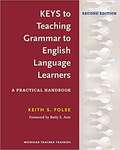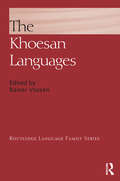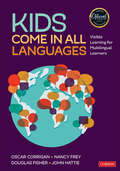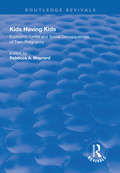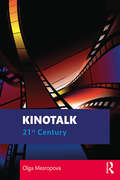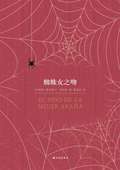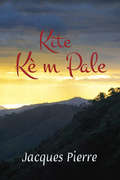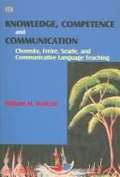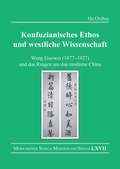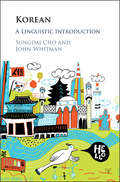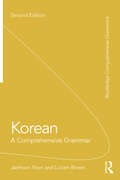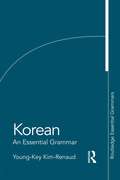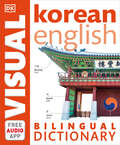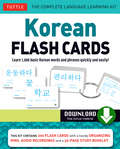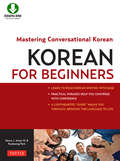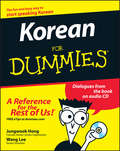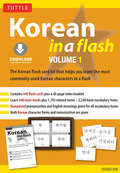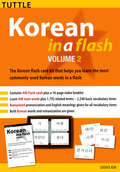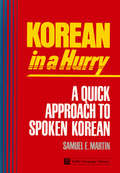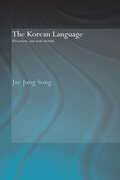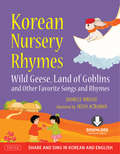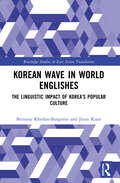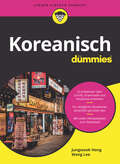- Table View
- List View
Keys to Teaching Grammar to English Language Learners: A Practical Handbook
by Keith S. Folse Betty S. AzarKeys to Teaching Grammar to English Language Learners: A Practical Handbook is not intended to be an exhaustive reference book about ESL grammar. Written for classroom teachers (K-12, ESL, EFL), this book teaches the most common ESL grammar points in an accessible way through real ESL errors together with suggested teaching techniques. Relevant grammar terminology is explained. <P><P> The four objectives of this book are to help teachers: (1) identify common ESL grammar points and understand the details associated with each one; (2) improve their ability to answer any grammar question on the spot (when on the “hot seat”); (3) anticipate common ESL errors by grammar point, by first language, and/or by proficiency level; and (4) develop more effective grammar/language learning lessons. These objectives are for all teachers, whether they are teaching grammar directly or indirectly in a variety of classes – including a grammar class, a writing class, a speaking class, an ESP class, or a K-12 class. <P><P> In the Second Edition, all chapters have been updated and substantively revised. The number of marginal (gray) boxes with tips and extra information has doubled. A 16th Key, on Negating, and three new appendixes have been added. One of the new appendixes provides a sample exercise from an actual ESL textbook plus relevant notes about the designing of grammar activities and suggestions for teaching each grammar point. <P><P> Also added to each Key is a section on the vocabulary items (e.g., collocations) that are related to the teaching of that particular grammar point. This information is unique to this edition and cannot be found elsewhere on the market. <P><P> The Workbook for the Second Edition (978-0-472-03679-0), available in 2017, includes numerous activities that practice the essentials of grammar and issues relevant to ESL teachers.
The Khoesan Languages (Routledge Language Family Series)
by Rainer VossenThe Routledge Language Family series is aimed at undergraduates and postgraduates of linguistics and language, and those with an interest in historical linguistics, linguistic anthropology and language development. According to a widely accepted hypothesis, the Khoesan languages represent the smallest of the four language phyla in Africa, geographically distributed mainly in Botswana and Namibia. Today, only 30 or so Khoesan languages may still exist, with about 300,000 native speakers. In other words, most Khoesan languages were already extinct before a sound scholarly interest in them could begin to develop. Drawing together a distinguished group of international experts, with much of the material taken from data collected by the authors’ own field work, this volume presents descriptive, typological, historical-comparative and sociolinguistic material on Khoesan. The Khoesan Languages contains eight sections: an introduction, an overview of genetic relationships, a typological survey and profile of Khoesan, four chapters covering core linguistic areas of Khoesan phonetics and phonology, tonology, morphology and syntax, and a final chapter tackling major issues in Khoesan sociolinguistics, as well as discussions of language contact. Comprehensive and scholarly, yet also lucid in its coverage of a broad range of languages, dialects and sub-groups, this unprecedented and original work represents the current state of Khoesan linguistics.
Kids Come in All Languages: Visible Learning for Multilingual Learners (Corwin Literacy)
by Oscar Corrigan Nancy Frey Douglas Fisher John HattieEverything you need to create a high-trust, high-achieving learning environment for multilingual students We have never known more than we do now about teaching multilingual students — nevertheless, we teeter on the edge of retreating to old-think practices. The next generation depends upon our getting this right, and this spare, salient guide helps ensure we do. Kids Come in All Languages provides teachers and leaders with all they need to design high-quality curriculum to support multilingual learners. With this book, learn to: Create a low-anxiety, high-expectation classroom climate that gives multilingual students access to engaging grade-level content Plan clear, cohesive lessons and tasks that motivate students to produce language, use critical thinking skills, and access complex texts Offer ample time for student-led talk that ramps up knowledge and amps up a sense of belonging Use heterogeneous, flexible grouping so children acquiring English don’t stall out in fixed-mindset, below-grade level groups And much more Teachers act like tributaries, helping learners access a wider stream of knowledge, and catch the swift current of wanting to learn. It’s time to envision this expansiveness for multilingual students. It’s time to design learning experiences with optimism for their futures.
Kids Come in All Languages: Visible Learning for Multilingual Learners (Corwin Literacy)
by Oscar Corrigan Nancy Frey Douglas Fisher John HattieEverything you need to create a high-trust, high-achieving learning environment for multilingual students We have never known more than we do now about teaching multilingual students — nevertheless, we teeter on the edge of retreating to old-think practices. The next generation depends upon our getting this right, and this spare, salient guide helps ensure we do. Kids Come in All Languages provides teachers and leaders with all they need to design high-quality curriculum to support multilingual learners. With this book, learn to: Create a low-anxiety, high-expectation classroom climate that gives multilingual students access to engaging grade-level content Plan clear, cohesive lessons and tasks that motivate students to produce language, use critical thinking skills, and access complex texts Offer ample time for student-led talk that ramps up knowledge and amps up a sense of belonging Use heterogeneous, flexible grouping so children acquiring English don’t stall out in fixed-mindset, below-grade level groups And much more Teachers act like tributaries, helping learners access a wider stream of knowledge, and catch the swift current of wanting to learn. It’s time to envision this expansiveness for multilingual students. It’s time to design learning experiences with optimism for their futures.
Kids Having Kids: Economic Costs and Social Consequences of Teen Pregnancy (Routledge Revivals)
by Rebecca A. MaynardPublished in 1997. Adolescent mothers are more likely to encounter a variety of economic and social ills than women who delay childbearing until they are adults. This work is a comprehensive examination of the extent to which these undesirable outcomes are attributable to teen pregnancy itself rather than to the wider environment in which most of the pregnancies and the subsequent child-rearing take place. It also examines the consequences of adolescent pregnancy for the fathers of children, and even more importantly, for the children themselves.
Kinotalk: 21st Century
by Olga MesropovaKinotalk: 21st Century is a cinema-based textbook that enhances students’ linguistic and cultural proficiency through guided studies of 12 Russian feature films released since the year 2000. Each chapter includes a series of original readings and activities that present captivating and thought-provoking frameworks in which students of Russian can practice and perfect all four language skills. While providing active stimuli for language production, the volume also aims to immerse students in the world of Russian cinema, society, and culture. Key features include: A broad cross-section of prominent films, directors, cinematic styles, trends, and genres that have emerged in Russia since 2000. A wide selection of authentic texts from Russian scholars and film critics that familiarize students with the language of critical film inquiry in Russian. A multi-disciplinary approach that combines close readings of individual films with considerations of the socio-political, ideological, and economic contexts of their production. A flexible and dynamic modular structure that allows instructors to pick and choose films and topics that are best suited for their classrooms. Aimed at the Intermediate-High to Advanced levels (B1-C1, CEFR levels), this textbook is designed for all those interested in the rich palette of voices, genres, and contexts of 21st-century Russian cinema.
Kiss of a Spider Woman (Mandarin Edition)
by Manuel PuigIn the still darkness of their cell, Molina re-weaves the glittering and fragile stories of the film he loves, and the cynical Valentin listens. Valentin believes in the just cause which makes all suffering bearable; Molina believes in the magic of love which makes all else endurable. Each has always been alone, and always - especially now - in danger of betrayal. But in cell 7 each surrenders to the other something of himself that he has never surrendered before. 在阿根廷布宜诺斯艾利斯监狱的一间牢房里关押着两个囚犯 一个是政治犯瓦伦丁 另一个是同性恋者莫利纳 特务机关派到瓦伦丁身边的卧底 两人之间展开了一场奇妙的对话 呈现出一幅幅电影与现实交错的画面 本书1976年发表后 被翻译成多种文字 小说的魅力迅速蔓延开去 转化到各种表现形式 歌舞剧多年来久演不衰 成为百老汇经典 改编的电影产生过巨大的影响
Kite Kè m Pale
by Jacques PierreIn his latest collection of poetry, Kite Kè m pale (Let My Heart Speak), Jacques speaks lovingly and eloquently about those, including women, who have faced and continue to face difficulties and injustice. His poetry sometimes resorts to uncommon forms of Kreyòl such as jagon and bolit to better expressed that which cannot conveyed commonly, and expose everyone to the linguistic wealth of the country.
Kite Kè m Pale
by Jacques PierreJacques Pierre louvri kè l de batan nan Kite kè m pale pou l envite nou viv kouman entimite ak pwoblèm sosyal pran randevou nan menm kalfou. Powèt la fotografye difikilte ak kouran santiman ki travèse lavi medam yo. Epi, li wete chapo li byen ba pou li salye kouraj Martin Luther King Jr, Malcolm X, ak lòt lidè ki pa te pè batay pou yon minorite ki pran nan cho, e yo mete nan kacho souvan poutèt po yo. Pou fini, li envite nou viv de twa powèm nan langaj jagon ak bolit, epi yon katafal lòt ki fè yonn ak pafen lawouze nou jwenn nan bèl lang nou an.Rekèy powèm sa a se yon envitasyon otè a fè nou tout pou nou dekouvri bèlte lang nou an. Nan chak grenn mo, otè a plonje kè nou nan lanmè Karayib la, kote vag yo fè nanm nou tonbe nan yon ale vini jouk kouran lanmou an rale nou pou nou fè yonn ak powèm yo. -Wedsly Turenne GuerrierLang nou ak kilti nou se rezilta kreyativite nou ki pran nanm nan lavi chak kretyen vivan. Se sa potorik otè Jacques Pierre fè nan rekèy sa a. Pierre marinen lang nou ak kilti nou ansanm pou ofri nou yon konsonmen kreyativite ki se temwayaj richès kiltirèl ak lengwistik Ayiti cheri nou an. -Marky Jean-Pierre
Knowledge, Competence, and Communication: Chomsky, Freire, Searle, and Communicative Language Teaching
by William H. WalcottIn Knowledge, Competence, and Communication, author William H. Walcott debates the meaning of creating equitable and critical instructional practices by exploring diverse representations of knowledge. He covers both historically important topics and current issues: such as colonialism, multiculturalism, gender and language learning, and popular culture. He then presents a systematic and painstaking assessment of Noam Chomsky's and Paulo Freire's theories of knowledge and their educational relevance. In the end, Walcott makes his case for the Freireian approach-conscientizacao; it is the Freireian, with its sociological connection (necessitated by the global context of inequality), which, he believes, needs take precedence as a pedagogical practice.
Konfuzianisches Ethos und westliche Wissenschaft: Wang Guowei (1877-1927) und das Ringen um das moderne China (Monumenta Serica Monograph Series)
by Hu QiuhuaThis study in German offers profound insights into the life and thoughts of Wang Guowei (1877-1927). Like many intellectuals who strongly perceived the necessity of reforms in the waning years of the Late Qing dynasty, i.e. after the Opium wars, Wang sought to strengthen China's position against foreign, in particular Western, powers. Contrary to earlier approaches, which either advocated a close adherence to Confucian traditions or tried to adapt only elements of Western material culture, mainly industrial and military technology, Wang Guowei aimed at reviving traditional Chinese culture by analysing its source texts using a modern scientific approach (and thereby started the discipline of guoxue [national studies]) and simultaneously adapting compatible elements of Western immaterial culture. Thus, Wang became known as an authority on Chinese paleography as well as on German philosophy, especially Kantian epistomology.
Korean: A Linguistic Introduction (Klear Textbooks In Korean Language Ser. #No. 34)
by Sungdai Cho John WhitmanIn this accessible survey, two leading specialists introduce a broad range of topics in Korean linguistics, including the general historical background of the language, its phonetics, phonology, morphology, syntax, semantics, pragmatics, and sociolinguistics, and the interfaces between those areas. Expertly written and drawing on the authors' many years of experience, the book answers questions such as what languages is Korean related to, what is unique about the Korean sound system, and how are 'subject' and 'topic' distinguished in Korean. It guides the student through the major issues in Korean linguistics in a theory-neutral way, at the same time discussing the latest research on the language, and exploring its unique writing system, which has long been a topic of interest to linguists and to those interested in writing systems in general. It is the ideal introduction for students both at the beginning of their studies, and at a more advanced level.
Korean: A Comprehensive Grammar (ISSN)
by Jaehoon Yeon Lucien BrownKorean: A Comprehensive Grammar is a reference to Korean grammar, and presents a thorough overview of the language, concentrating on the real patterns of use in modern Korean. The book moves from the alphabet and pronunciation through morphology and word classes to a detailed analysis of sentence structures and semantic features such as aspect, tense, speech styles and negation.Updated and revised, this new edition includes lively descriptions of Korean grammar, taking into account the latest research in Korean linguistics. More lower-frequency grammar patterns have been added, and extra examples have been included throughout the text.The unrivalled depth and range of this updated edition of Korean: A Comprehensive Grammar makes it an essential reference source on the Korean language.
Korean: An Essential Grammar (Routledge Essential Grammars)
by Young-Key Kim-RenaudKorean: An Essential Grammar is a concise and convenient guide to the basic grammatical structure of standard Korean. Presenting a fresh and accessible description of the language, this engaging Grammar uses clear, jargon-free explanations and sets out the complexities of Korean in short, readable sections. Key features include: clear explanations of grammatical terms frequent use of authentic examples the Korean alphabet used alongside McCune-Reischauer romanization system a full glossary of explanations.
Korean-English Bilingual Visual Dictionary (DK Bilingual Visual Dictionaries)
by DKWith over 6,500 fully illustrated words and phrases in Korean and English, along with a free bilingual audio app, using and learning Korean has never been easier.Perfect for tourists, business travellers and students, DK's Korean English Bilingual Visual Dictionary is your essential companion when buying food, talking about work, discussing health, and studying the Korean language.The dictionary is incredibly easy to follow, with thematically organized vocabulary so you can find closely related words on a particular topic. Words and phrases are illustrated with full-colour photographs and artworks, helping to fix new vocabulary in your mind. A comprehensive two-way index provides an instant reference point for new Korean vocabulary.The supporting audio app enables you to hear over 6,500 words and phrases spoken out loud in both Korean and English. Available on the App Store and Google Play, the audio app is easy to use and provides an intuitive reference for language learning, helping you learn, retain, and pronounce important vocabulary. The dictionary gives a pronunciation guide for every Korean word, and you can use this alongside the app to perfect your pronunciation.
Korean Flash Cards: Learn 1,000 Basic Korean Words and Phrases Quickly and Easily!
by Woojoo Kim Soohee KimEverything needed to learn to read, write, speak, and understand the basic and most useful words in the Korean language is in this handy set of flash cards-including many hundreds of phrases and sentences using them.<P><P> The cards in this volume are a great way to learn Korean and contain the most common words and expressions used in daily Korean communication-concrete nouns as well as verbs and adjectives that form the core Korean vocabulary. These are grouped thematically to enable easy memorization and retention. A sample sentence is given to illustrate the use of the main word on each card which is often a well-known Korean saying or an idiom.Each card features on the FRONT: Main word, plus 4 related words and phrases to help you use it....And on the BACK: Main word and related words' English meanings, Korean script and romanizations. A sample sentence in Korean, romanization, and English translation.
Korean for Beginners: Mastering Conversational Korean
by Kyubyong Park Henry J. Amen IVHave you ever considered learning Korean, but been put off by the unusual look of the characters? Don't let yourself be scared away! <P><P>Korean has been called "the most logical language there is," and with this friendly and thorough introduction you will soon see why.The best way to learn Korean-this book uses a lighthearted, humorous approach. Korean for Beginners starts by showing you just how reasoned and logical the Korean alphabet, hangeul, actually is, and helps you master it faster than you learned the English alphabet. Realistic situations you might encounter in Korea in Korean-speaking environments are described, and new words are explained in terms of how you'll find them useful to communicate. Numerous illustrations enliven the text, and downloadable material lets you listen and repeat phrases in the book. Soon you'll be able to say with pride, "I know Korean!" Features of Korean for Beginners are: Learn to read Korean writing with ease. Practical phrases help you converse with confidence. A lighthearted "guide" walks you through, bringing the language to life.As the more than 1 million Americans who speak Korean can attest, the Korean language is here to stay, and generations of young (and older) adults are determined to learn it. This book is for people who want a grasp of how to speak, write and understand Korean-and who want to enjoy things while they're at it!
Korean For Dummies
by Jungwook Hong Wang LeeStart speaking Korean the fun and easy way with Korean For Dummies, a no-nonsense guide to Korean culture and the basics of Korean language. Pick up basic phrases and commonly used words so that you can converse with Koreans in both business and personal situations. You'll learn Korean for everyday life and task-specific expressions for Korean on the go. In addition, you'll discover important and fascinating aspects of Korean culture.This handy guide won't burden you with lists of grammar rules; just look up the phrases and cultural phrases that you need or read through the whole book for a general overview. You'll be able to place material in a daily context with cultural tidbits, phonetic spelling of Korean words, and the recorded Korean dialogues on the accompanying CD. Exercises will jog your memory and reinforce everything that you learn. Find out how to:Use basic phrases and words correctlyConverse intelligently about Korean cultureDo business with a Korean companySay task-specific expressionsPronounce Korean wordsPut material in a real-world contextMake a good first impression with KoreansComplete with lists of ten ways to learn Korean quickly, ten phrases to make you sound Korean, ten expressions that Koreans like to use, and ten things you should never do around a Korean, Korean For Dummies is your one-stop guide to speaking basic Korean and understanding the fundamentals of Korean culture.
Korean in a Flash Kit Volume 1
by Soohee KimKorean in a Flash Volume 1 is an excellent new language learning resource for travelers and others who want to learn Korean quickly and easily.<P><P>Part of the bestselling Tuttle In a Flash series, this complete boxed set of Korean character flash cards aids in recognition, vocabulary learning, review and self-testing. Korean in a Flash has a full range of features to help beginners and intermediate learners alike. Flash cards feature the most commonly used Korean words and phrases. Sample sentences in Korean are provided, along with related terms, frequently-used expressions and extended vocabulary. Contains 448 flash cards plus a 48 page index booklet. Learn 448 main words plus 1,792 related terms and 2,240 basic vocabulary items.Romanized pronunciation and English meanings given for all vocabulary items. Both Korean character forms and romanization are given.
Korean in a Flash Volume 2
by Soohee KimKorean in a Flash Volume 2 continues the learning-tool advantage for people interested in learning Korean quickly and easily.<P><P>This complete boxed set of flash cards has a full range of acclaimed features to help beginners and intermediate learners, and covers the second most-basic Korean words, plus related terms and phrases--in a flash! Contains 448 flash cards plus a 48 page index booklet. Learn 448 main words plus 1,792 related terms and 2,240 basic vocabulary items. Romanized pronunciation and English meanings given for all vocabulary items. Both Korean character forms and romanization are given.
Korean in a Hurry: A Quick Approach to Spoken Korean
by Samuel E. MartinThis is a useful manual of the Korean language. These lessons have been devised to facilitate easy language study and are conversationally applicable as soon as you learn them. This book has been printed in a handy pocket-size format.
The Korean Language: Structure, Use and Context
by Jae Jung SongSuitable for students of all levels, this book provides a general description of the Korean language by highlighting important structural aspects whilst keeping technical details to a minimum. By examining the Korean language in its geographical, historical, social and cultural context the reader is able to gain a good understanding of its speakers and the environment in which it is used. The book covers a range of topics on Korean including its genetic affiliation, historical development, sound patterns, writing systems, vocabulary, grammar and discourse. The text is designed to be accessible, primarily to English-speaking learners of Korean and scholars working in disciplines other than linguistics, as well as serving as a useful introduction for general linguists. The book complements Korean language textbooks used in the classroom and will be welcomed not only by readers with a wider interest in Korean studies, but also by Asian specialists in general.
Korean Nursery Rhymes
by Danielle Wright Helen AcramanA charming collection of fourteen well-loved rhymes, Korean Nursery Rhymes is the perfect introduction to Korean language and culture for young readers.This beautifully illustrated book features songs and rhymes perfect for children who are interested in learning the Korean language or about its culture. Presented in both English and Korean, this multicultural children's book also includes an audio CD with recordings of kids singing in both languages -- songs so lively and sweet, you'll soon find yourself singing along! Many accompany everyday play activities like jum rope and hand clap games. Others speak to a child's view of nature, and a love of home.Favorite rhymes and songs include: Little One Monkey's Bottom Twirling Round Spring in My Hometown And more!For preschoolers and beyond, this book will be a joy to the mind, the eye, the ear and the heart.
Korean Wave in World Englishes: The Linguistic Impact of Korea's Popular Culture
by Brittany Khedun-Burgoine Jieun KiaerThis book examines the linguistic impact of the Korean Wave on World Englishes, demonstrating that the K-Wave is not only a phenomenon of popular culture, but also language. The "Korean Wave" is a neologism that was coined during the 1990s that includes K-pop, K-dramas, K-film, K-food, and K-beauty, and in recent years it has peaked in global popularity. This book intends to show how social media phenomena have facilitated the growth of Korea’s cultural influence globally and enabled a number of Korean origin words to settle in varieties of Englishes. This in turn has globalised Korean origin words and revolutionised the English language through an active and collaborative process of lexical migration. Korean origin words such as oppa (older brother) are no longer bound solely to Korean-speaking contexts. The study focuses primarily on media content, particularly social media, corroborated by case studies to examine how linguistic innovation has been engendered by the Korean Wave. Suitable for students and researchers of Korean linguistics, Korean culture, Korean popular culture, and translation studies, this book is the first detailed study of the global linguistic impact of the Korean Wave.
Koreanisch für Dummies (Für Dummies)
by Jungwook Hong Wang LeeKorea erscheint uns Deutschen so fremd und unverständlich wie faszinierend - und das nicht erst seit K-Pop. Dieses Buch bietet Lesern eine grundlegende Einführung in die koreanische Sprache und Kultur: Angefangen beim Schriftsystem und der Aussprache über Grundlagen zu Grammatik und Vokabular bis hin zu einfachem Small Talk. Der Fokus liegt dabei auf der praktischen Anwendbarkeit: Alle Lektionen werden direkt anhand von praktischen Situationen eingeübt. Ein Buch für alle, die ihre neuen Koreanisch-Kenntnisse von Anfang an in die Praxis umsetzen möchten.
